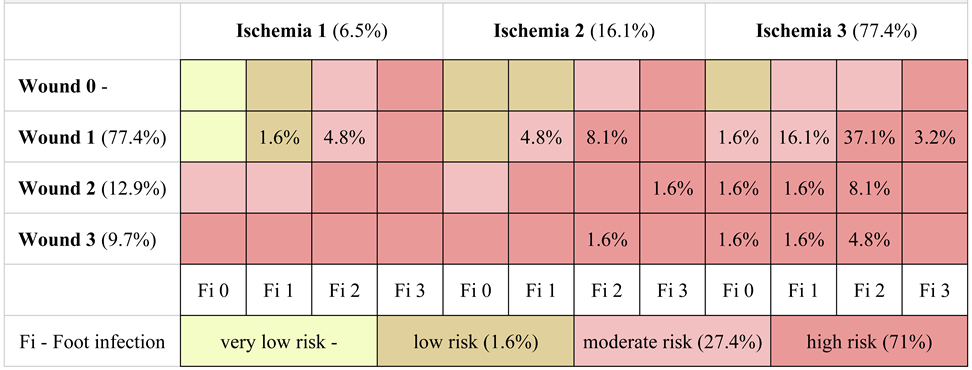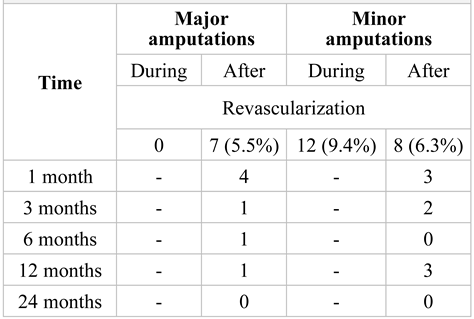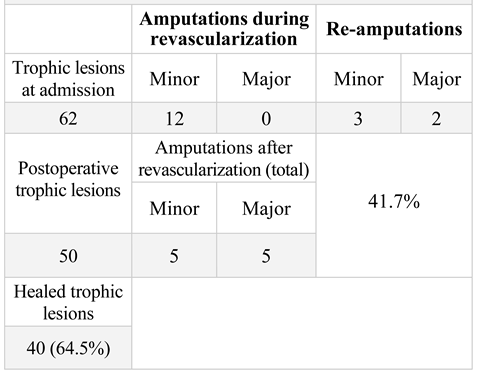Assessing Mid to Long Term Amputation-Free Survival Rates in Chronic Limb-Threatening Ischemia; A Study of Hybrid Vascular Techniques
Abstract
Highlights
- ✓
- The study on chronic limb-threatening ischemia underscores the paramount importance of amputation-free survival as a critical outcome measure in vascular surgery.
- ✓
- It highlights the efficiency of hybrid revascularization techniques for limb loss prevention as well as its role in complex wound healing.
Abstract
Introduction
Materials and Methods
Results
Discussions
Conclusions
Author Contributions
Informed Consent Statement
Conflicts of Interest
References
- Duff, S.; Mafilios, M.S.; Bhounsule, P.; Hasegawa, J.T. The burden of critical limb ischemia: a review of recent literature. Vasc. Heal. Risk Manag. 2019, 15, 187–208. [Google Scholar] [CrossRef]
- Wübbeke, L.F.; Naves, C.C.; Daemen, J.-W.H.; Jacobs, M.J.; Mees, B.M. Editor’s Choice – Mortality and Major Amputation after Revascularisation in Octogenarians Versus Non-Octogenarians with Chronic Limb Threatening Ischaemia: A Systematic Review and Meta-Analysis. Eur. J. Vasc. Endovasc. Surg. 2020, 60, 231–241. [Google Scholar] [CrossRef] [PubMed]
- Ventoruzzo, G.; Mazzitelli, G.; Ruzzi, U.; Liistro, F.; Scatena, A.; Martelli, E. Limb Salvage and Survival in Chronic Limb-Threatening Ischemia: The Need for a Fast-Track Team-Based Approach. J. Clin. Med. 2023, 12, 6081. [Google Scholar] [CrossRef] [PubMed]
- Hawkins, B.M.; Li, J.; Wilkins, L.R.; Carman, T.L.; Reed, A.B.; Armstrong, D.G.; Goodney, P.; White, C.J.; Fischman, A.; Schermerhorn, M.L.; et al. SCAI/ACR/APMA/SCVS/SIR/SVM/SVS/VESS Position Statement on Competencies for Endovascular Specialists Providing CLTI Care. Vasc. Med. 2022, 27, 405–414. [Google Scholar] [CrossRef] [PubMed]
- Berchiolli, R.; Bertagna, G.; Adami, D.; Canovaro, F.; Torri, L.; Troisi, N. Chronic Limb-Threatening Ischemia and the Need for Revascularization. J. Clin. Med. 2023, 12, 2682. [Google Scholar] [CrossRef]
- Benoit, E.; O’Donnell, T.F.; Kitsios, G.D.; Iafrati, M.D. Improved amputation-free survival in unreconstructable critical limb ischemia and its implications for clinical trial design and quality measurement. J. Vasc. Surg. 2012, 55, 781–789. [Google Scholar] [CrossRef]
- Verwer, M.C.; Wijnand, J.G.; Teraa, M.; Verhaar, M.C.; de Borst, G.J. Long Term Survival and Limb Salvage in Patients With Non-Revascularisable Chronic Limb Threatening Ischaemia. Eur. J. Vasc. Endovasc. Surg. 2021, 62, 225–232. [Google Scholar] [CrossRef]
- Joshi, G.S.; Zhang, S.M.; Wang, K.; El Khoury, R.; Cataneo, J.; Jacobs, C.E.; White, J.V.; Schwartz, L.B. Predictors of Amputation-free Survival after Endovascular Intervention for Chronic Limb-Threatening Ischemia in the Modern era. Ann. Vasc. Surg. 2022, 86, 268–276. [Google Scholar] [CrossRef]
- Miyata, T.; Kumamaru, H.; Mii, S.; Kinukawa, N.; Miyata, H.; Shigematsu, K.; Azuma, N.; Ishida, A.; Izumi, Y.; Inoue, Y.; et al. Prediction Models for Two Year Overall Survival and Amputation Free Survival After Revascularisation for Chronic Limb Threatening Ischaemia. Eur. J. Vasc. Endovasc. Surg. 2022, 64, 367–376. [Google Scholar] [CrossRef]
- Bradbury, A.W.; Adam, D.J.; Bell, J.; Forbes, J.F.; Fowkes, F.G.R.; Gillespie, I.; Ruckley, C.V.; Raab, G.M. Bypass versus Angioplasty in Severe Ischaemia of the Leg (BASIL) trial: An intention-to-treat analysis of amputation-free and overall survival in patients randomized to a bypass surgery-first or a balloon angioplasty-first revascularization strategy. J. Vasc. Surg. 2010, 51 (Suppl. 5), 5S–17S. [Google Scholar] [CrossRef]
- Adams, G.L.; Lichtenberg, M.; Wissgott, C.; Schmidt, A.; Tarra, T.; Matricardi, S.; Geraghty, P.J. Twenty-Four Month Results of Tack-Optimized Balloon Angioplasty Using the Tack Endovascular System in Below-the-Knee Arteries. J. Endovasc. Ther. 2023, 30, 393–400. [Google Scholar] [CrossRef] [PubMed]
- Strøm, M.; Konge, L.; Lönn, L.; Schroeder, T.V.; Rørdam, P. Amputation-Free Survival after Crural Percutaneous Transluminal Angioplasty for Critical Limb Ischemia. Scand. J. Surg. 2016, 105, 42–48. [Google Scholar] [CrossRef] [PubMed]
- Lebreton, O.; Fels, A.; Compagnon, A.; Lazareth, I.; Ghaffari, P.; Chatellier, G.; Emmerich, J.; Michon-Pasturel, U.; Priollet, P.; Yannoutsos, A. Amputation-free survival in the long-term follow-up and gender-related characteristics in patients revascularized for critical limb ischemia. J. Med. Vasc. 2023, 48, 105–115. [Google Scholar] [CrossRef]
- Chang, H.; Rockman, C.B.; Jacobowitz, G.R.; Cayne, N.S.; Veith, F.J.; Han, D.K.; Patel, V.I.; Kumpfbeck, A.; Garg, K. Interplay of Diabetes Mellitus and End-Stage Renal Disease in Open Revascularization for Chronic Limb-Threatening Ischemia. Ann. Vasc. Surg. 2021, 72, 552–562. [Google Scholar] [CrossRef]
- Conte, M.S.; Bradbury, A.W.; Kolh, P.; White, J.V.; Dick, F.; Fitridge, R.; Mills, J.L.; Ricco, J.-B.; Suresh, K.R.; Murad, M.H.; et al. Global Vascular Guidelines on the Management of Chronic Limb-Threatening Ischemia [published correction appears in Eur J Vasc Endovasc Surg. 2020 Mar;59(3):492-493] [published correction appears in Eur J Vasc Endovasc Surg. 2020 Jul;60(1):158-159]. Eur. J. Vasc. Endovasc. Surg. 2019, 58, S1–S109.e33. [Google Scholar] [CrossRef]
- Paius, C.T.; Constantin, V.D.; Carap, A.; Tarus, A.; Tinica, G. Revascularization impact: quality of life enhancement in chronic limb-threatening ischemia. J. Mind Med Sci. 2023, 10, 321–329. [Google Scholar] [CrossRef]
- Karimi, A.; Lauria, A.L.; Aryavand, B.; Neville, R.F. Novel Therapies for Critical Limb-Threatening Ischemia. Curr. Cardiol. Rep. 2022, 24, 513–517. [Google Scholar] [CrossRef]
- Constantin, V.D.; Socea, B.; Gaspar, B.S.; Epistatu, D.; Paunica, I.; Dumitriu, A.S.; Paunica, S.; Silaghi, A. Limb amputations; etiopathogenesis, diagnosis and the multidisciplinary therapeutic approach. J. Mind Med Sci. 2022, 9, 209–223. [Google Scholar] [CrossRef]
- Demidova-Rice, T.N.; Hamblin, M.R.; Herman, I.M. Acute and Impaired Wound Healing: Pathophysiology and current methods for drug delivery, part 1: Normal and chronic wounds: Biology, causes, and approaches to care. Adv. Skin Wound Care 2012, 25, 304–314. [Google Scholar] [CrossRef]
- Gabel, J.; Bianchi, C.; Possagnoli, I.; Mehta, R.; Abou-Zamzam, A.M.; Teruya, T.; Kiang, S.; Bishop, V.; Valenzuela, A. Multidisciplinary approach achieves limb salvage without revascularization in patients with mild to moderate ischemia and tissue loss. J. Vasc. Surg. 2020, 71, 2073–2080.e1. [Google Scholar] [CrossRef]
- Tanasescu, D.; Moisin, A.; Fleaca, R.; Popa, C.; Bacila, C.; Mohor, C.; Gherman, C.D.; Gaspar, B.; Tanasescu, C. Modern therapeutic options in diabetic foot ulcer. J. Mind Med Sci. 2022, 9, 285–293. [Google Scholar] [CrossRef]
- Huerta, C.T.; Voza, F.A.; Ortiz, Y.Y.; Liu, Z.-J.; Velazquez, O.C. Mesenchymal stem cell-based therapy for non-healing wounds due to chronic limb-threatening ischemia: A review of preclinical and clinical studies. Front. Cardiovasc. Med. 2023, 10, 1113982. [Google Scholar] [CrossRef] [PubMed]
- Chinaroonchai, K. Oxygen Therapy to Enhance Wound Healing After Revascularization. Int. J. Low. Extremity Wounds 2024, 23, 49–54. [Google Scholar] [CrossRef]
- Chiang, N.; Rodda, O.A.; Sleigh, J.; Vasudevan, T. Effects of topical negative pressure therapy on tissue oxygenation and wound healing in vascular foot wounds. J. Vasc. Surg. 2017, 66, 564–571. [Google Scholar] [CrossRef]
- Gormley, S.; Hart, O.; French, S.; O’shea, C.; Khashram, M. The use of fetal bovine acellular dermal matrix in severe diabetic foot ulceration and threatened limbs with tissue loss the use of FBADM as an adjunct for complex wounds. Vascular 2022, 32, 619–625. [Google Scholar] [CrossRef]
- Vivekanand, V.; Motukuru, V.; Kolalu, S.; Rangaswamy, G.K.; Jain, P. Effect of Comorbidities on Outcomes of Infrapopliteal Angioplasty in Patients with Chronic Limb-Threatening Ischemia. Innov. Technol. Tech. Cardiothorac. Vasc. Surg. 2022, 17, 392–400. [Google Scholar] [CrossRef]
- Campbell, D.B.; Sobol, C.G.; Stacy, M.R.; Atway, S.; Teng, X.; Haurani, M.J.; Go, M.R. Revascularization Outcomes Stratified by Glycemic Control in Patients with Diabetes Mellitus and Chronic Limb-Threatening Ischemia. Ann. Vasc. Surg. 2024, 100, 91–100. [Google Scholar] [CrossRef]




 |
 |
 |
 |
 |
© 2024 by the authors. 2024 Cristian Traian Paius, Vlad Denis Constantin, Alexandru Carap, Andrei Tarus, Grigore Tinica.
Share and Cite
Paius, C.T.; Constantin, V.D.; Carap, A.; Tarus, A.; Tinica, G. Assessing Mid to Long Term Amputation-Free Survival Rates in Chronic Limb-Threatening Ischemia; A Study of Hybrid Vascular Techniques. J. Mind Med. Sci. 2024, 11, 132-138. https://doi.org/10.22543/2392-7674.1496
Paius CT, Constantin VD, Carap A, Tarus A, Tinica G. Assessing Mid to Long Term Amputation-Free Survival Rates in Chronic Limb-Threatening Ischemia; A Study of Hybrid Vascular Techniques. Journal of Mind and Medical Sciences. 2024; 11(1):132-138. https://doi.org/10.22543/2392-7674.1496
Chicago/Turabian StylePaius, Cristian Traian, Vlad Denis Constantin, Alexandru Carap, Andrei Tarus, and Grigore Tinica. 2024. "Assessing Mid to Long Term Amputation-Free Survival Rates in Chronic Limb-Threatening Ischemia; A Study of Hybrid Vascular Techniques" Journal of Mind and Medical Sciences 11, no. 1: 132-138. https://doi.org/10.22543/2392-7674.1496
APA StylePaius, C. T., Constantin, V. D., Carap, A., Tarus, A., & Tinica, G. (2024). Assessing Mid to Long Term Amputation-Free Survival Rates in Chronic Limb-Threatening Ischemia; A Study of Hybrid Vascular Techniques. Journal of Mind and Medical Sciences, 11(1), 132-138. https://doi.org/10.22543/2392-7674.1496



